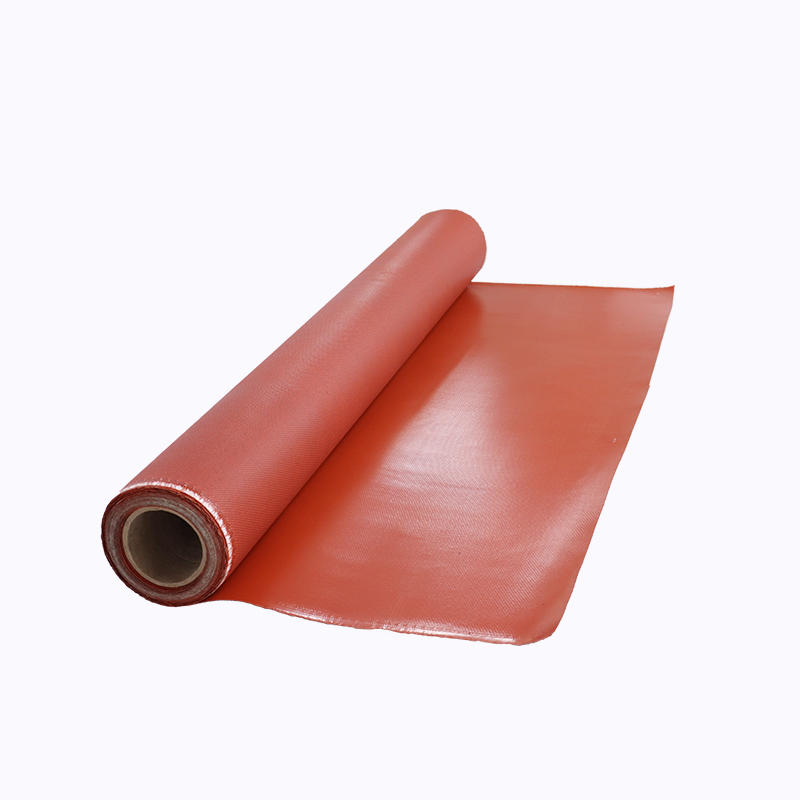High-Temperature and Fire Resistance: The Double-Coated Safety Guarantee
What sets silicone fiberglass fabric apart in the realm of industrial protective materials is its core advantage: combining the high-temperature resistance of fiberglass fabric with the protective capabilities of a silicone coating. The fiberglass cloth itself provides a solid, fireproof foundation with its extremely high melting point and non-combustible nature. The double-sided or single-sided silicone coating then forms a dense, flexible, and heat-resistant protective film on its surface. This layer of silicone can not only withstand continuous high temperatures reaching hundreds of degrees Celsius but also momentarily resist even higher thermal shocks. When exposed to open flames, it effectively isolates the heat source and prevents fire from penetrating, providing crucial buffer time for the equipment or personnel it’s protecting. This dual-protection mechanism makes silicone fiberglass fabric the ideal material for manufacturing fire blankets, fire curtains, and welding shields. It is widely used in high-safety-demand industries like metallurgy, chemicals, shipbuilding, and aerospace, constructing a robust line of defense for both lives and property.
Flexible Connections: Solving the Challenges of Pipe Expansion and Vibration
In many complex industrial piping systems, displacement caused by thermal expansion and contraction or equipment vibration is often the culprit behind pipe damage and leaks. Silicone fiberglass fabric, with its exceptional flexibility and high strength, offers an ideal solution to this problem. It is engineered into flexible expansion joints or soft connectors used to bridge two pipes or pieces of equipment. This type of flexible connection can effectively absorb the axial, radial, and angular displacements that occur during pipe operation, while also isolating the transmission of vibration and noise. Compared to traditional metal expansion joints, silicone fiberglass soft connectors are not only lighter and easier to install but also possess superior corrosion resistance, allowing them to adapt to a variety of complex media environments. This flexible design ensures the stability and safety of the entire piping system, preventing stress concentration and structural damage caused by rigid connections and significantly extending the service life of the equipment.
Water and Corrosion Resistance: A Powerful Guardian in Damp and Corrosive Environments
In many industrial and outdoor settings, equipment and pipes frequently face erosion from moisture, acids, alkalis, oil, and other corrosive substances. The silicone coating on silicone fiberglass fabric imparts excellent water and corrosion resistance, making it a reliable guardian in these harsh environments. Silicone itself is remarkably hydrophobic, effectively preventing moisture from penetrating and condensation from forming on the protected surface, thus preventing equipment from rusting or short-circuiting due to dampness. At the same time, the silicone coating has excellent resistance to a wide range of chemicals, including acids, alkalis, salts, and oils, effectively isolating these corrosive agents from the internal materials. This makes silicone fiberglass fabric a prime choice for wrapping outdoor pipes, covering equipment shells, and manufacturing liners for chemical storage tanks. It maintains its integrity and protective function even in humid, rainy, or chemically saturated environments.
Insulation Protection: Dual Isolation from Electricity and Heat
In the power and thermal industries, effective insulation protection is crucial for ensuring equipment safety and personnel well-being. Silicone fiberglass fabric, with its unique material combination, provides dual isolation from both electricity and heat. Fiberglass is an excellent insulating material by nature, and its non-conductive properties effectively prevent current leakage. The surface silicone coating further enhances its electrical insulation performance, allowing it to withstand higher voltages. In terms of heat, the low thermal conductivity of silicone fiberglass fabric makes it an efficient thermal barrier. It can be used to manufacture insulating sleeves, thermal pads, and fireproof insulation layers, effectively blocking the transfer of high-temperature heat. This dual-insulation capability makes silicone fiberglass fabric vital for cable insulation, heating element wraps, and high-temperature equipment insulation, simultaneously protecting equipment from overheating and ensuring the safety of operators, all while helping to improve energy utilization efficiency.
Abrasion and Aging Resistance: A Durable and Long-Lasting Industrial Choice
In industrial applications, material durability is of paramount importance. Silicone fiberglass fabric’s exceptional abrasion and aging resistance ensure its long-term, stable performance in demanding environments. The silicone coating provides a smooth yet tough surface that effectively resists external physical friction and impact. This makes it capable of withstanding frequent wear and tear when used as conveyor belts, protective covers, or linings for mechanical parts. Furthermore, the chemical properties of silicone are very stable, and it is not easily aged, embrittled, or cracked by UV rays, ozone, or atmospheric conditions. This resistance to aging allows silicone fiberglass fabric to maintain its original physical properties and appearance even in outdoor or sun-exposed environments. This rugged and durable characteristic not only reduces the frequency of maintenance and replacement but also provides a reliable, long-lasting solution for industrial applications, significantly lowering long-term operating costs.

